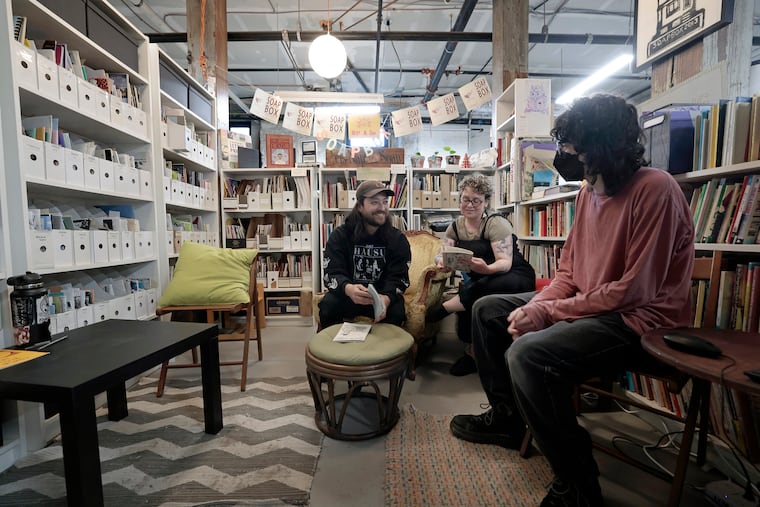The internet is over. Long live the zine.
The handmade, self-published book scene is thriving in Philly.

The zine libraries of Philadelphia are overflowing and the zinemakers stay busy.
In the stone basement of what used to be a church in West Philadelphia, the Soapbox has more than 3,000 zines stuffed into subject-area boxes: “Ableism,” “Punk,” “Erotica,” “International society of copier artists.” Temple University maintains thousands of zines in its Special Collections Research Center, with titles like I’m a horse, B— and Bad Highschool Poetry. The Free Library is currently starting their first ever zine collection.
Zines (pronounced like the last syllable of magazines) are handmade, self-published booklets, often xeroxed and stapled together for a small audience about a particular topic. Hallmarks of DIY culture, they have endured far longer than many of the forces that seemed sure to make them irrelevant.
“Tumblr is so over, and zines are still thriving,” said Beth Heinly, 42, an artist and zine librarian based in Brewerytown. Heinly’s first “official” zine was The 3:00 Book, a collection of comics and notes that she and her best friend drew in high school.
She has become an unofficial recordkeeper of Philadelphia zine culture. In 2014, she donated part of the zine library from Little Berlin, an artist collective in Kensington, to Temple University, forming the basis of their contemporary zine collection. Little Berlin just donated the rest of their zine archives — more than 850 books — to the Free Library of Philadelphia, which is currently cataloging them at the Parkway Central Library for public use.
Heinly and other Philly zinemakers said the craft endures specifically because zines are analog, objects that can be held and that can’t go viral.
“There’s something about the experience of the endless scrolling that is fleeting,” Heinly said, compared to the physical experience of reading a zine.
Because zines don’t have to be approved by a publisher, they often catalog life outside the mainstream, as seen by artists or queer people or punks or activists.
In turn, meaningful communities have sprung up around zines. Katie Haegele, 47, learned how to make zines in 2004 by removing the staples from one she already owned to see how it was made. Soon after, she attended the Philly Zine Fest, an annual zine market that has expanded in recent years. She quickly fell in love with the scrappy, DIY community, appreciating the inexpensive, democratic art form at its center.
“It was a very solitary thing for me, but then just spending one day there I felt a part of something,” Haegele said. She met her husband at a New Jersey zine fest in 2009 and has made a host of zine friends over the years. One of them, a “long distance zine friend” named Vanessa Berry, will be visiting Haegele from Australia this fall. They’ve never met in person, but have kept in touch by mailing zines back and forth.
When digital becomes the default medium for all that we do, people treasure physical objects — printed books, cassettes, records — in a new way, Haegele said, citing the scholar N. Katherine Hayles.
“Zines never went away. But they’re rediscovered every so often by new generations,” said Jill Luedke, the art and architecture librarian at Temple University Libraries. The Temple archives house science fiction fanzines from the 1930s, punk and Riot Grrl zines from the ‘80s and ‘90s, and a contemporary zine collection, seeded by Heinly, that continues to grow.
There are many historical precursors to the modern zine, going back to the origins of the printing press in the 15th century, said Kimberly Tully, librarian and curator of rare books at Temple. People have published ephemeral, noncommercial content for centuries. The biggest noticeable difference between the early zines of the 1930s and those of today is the technology used to create them — the ethos remains the same.
At the Soapbox, the West Philly community print shop that organizes the yearly Philly Zine Fest, people make zines using Riso, a large gray machine that looks like a generic photocopier, but produces particularly vibrant colors.
“There’s a huge Riso culture,” said Karen Lowry, a printmaker and public health graduate student who serves as Soapbox’s board president. “People geek out about Riso.”
Lowry grew up making zines in Lansdale, photocopying them with her friend at the local 7-Eleven.
Many zines are silly, absurd, and meant to be enjoyed in a particular moment in time. But perhaps they are also how future generations will understand our own.
Temple Libraries, for example, is showcasing a 4,000-year-old cuneiform tablet right now that documents wages being paid to sailors, said Tully.
“Just because we think it’s ephemeral doesn’t mean it won’t survive for 1,000 years,” she said.
There are a host of forthcoming zine events in Philly: A “zine swap” on May 3 at the Fabric Workshop and Museum; a zinemaking workshop on May 20 at the Bok building hosted by illustrator Emily Joynton; West Philly zine fest on June 22 at the Rotunda.